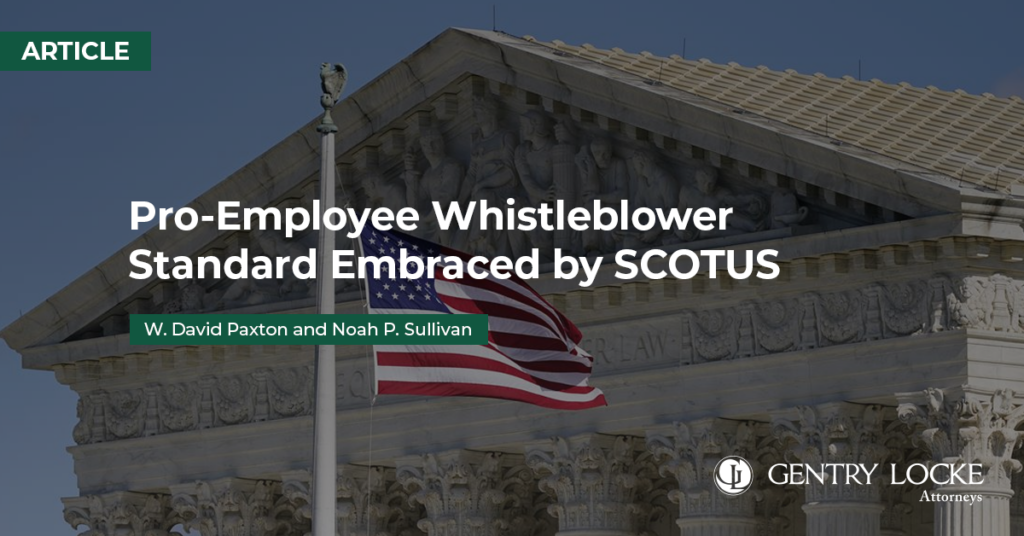Pro-Employee Whistleblower Standard Embraced by SCOTUS

On February 8, 2024, a unanimous United States Supreme Court ruled that whistleblowers bringing a retaliatory discharge claim under the Sarbanes-Oxley Act (“SOX”) are not required to prove that the employer acted with “retaliatory intent,” but need only prove that their “protected activity” was a “contributing factor” in the employer’s unfavorable personnel action. The ruling reversed a Second Circuit decision which had overturned a $900,000 jury verdict in favor of a former employee against UBS Securities, LLC.[1] The Court’s ruling is yet another disappointment for businesses hoping for greater judicial protection from the growing number of retaliation claims.[2]
Justice Sotomayor’s opinion for the Court noted two related reasons for the ruling. First, the statute, 18 U.S.C §1514A, does not reference or include a “retaliatory intent” or “animus” requirement. Instead, when Congress drafted SOX, it said no employer “may discharge, demote, … or in any other manner discriminate against an employee … because of” the employee’s protected whistleblowing activity. The Court noted that to “discriminate” typically means simply “to make a difference in treatment or favor of one as compared with others.” [3] Accordingly, the Second Circuit was wrong to conclude the word “discriminate” requires a plaintiff to prove the presence of a malevolent motive or “animus” on the part of the employer/decisionmaker.
Second, the Supreme Court observed that the statutory language[4] calls for the employer intent to be proved using the contributory factor burden-shifting framework used in most federal whistleblower protection laws.[5] The Court found that the “contributory factor” framework was specifically chosen by Congress in order that the protection provided would be plaintiff-friendly so that employees would not have to show that their protected activity was a “significant”, “motivating’, “substantial”. or “predominant” factor in making the adverse decision in this context.[6]
As Justice Alito noted in his concurring opinion, the Court’s decision still requires the plaintiff to prove that the employer treated him/her worse “because of” the protected activity, which involves an intentional act; however, the plaintiff need not prove the protected activity was the only reason, or even that it was the principal reason for the adverse decision. A showing that the protected activity “helped to cause or bring about” the decision is enough.
Once the employee comes forward with direct or circumstantial evidence that the protected activity helped to cause the adverse decision, the intent requirement is met and the burden then shifts to the employer to “demonstrate, by clear and convincing evidence, that the employer would have taken the same unfavorable personnel action in the absence of the protected behavior.” This burden shifting framework is meant to be plaintiff-friendly because discriminatory intent is often difficult to prove and the employer controls most of the relevant evidence. As Justice Alito noted, this framework in effect requires the employer to show that the employee’s protected activity did not cause the challenged employment decision.
The upshot is that retaliatory discharge claims will have even stronger staying power. In Murray, this meant a $2.7 million swing for the employer (between damages and attorney’s fees awarded to the plaintiff). Plaintiffs will surely like their chances at trial better with the more friendly standard adopted in Murray.
For more information about claims involving potential whistleblowers, please contact the lawyers at Gentry Locke who are frequently engaged to conduct internal investigations, to respond to government inquiries, to advise and represent management regarding employment decisions, and to represent companies and individual whistleblowers in litigation.
[1] See Murray v. UBS Securities LLC, 43 F.4th 254, 258 (2d Cir. 2022), rev’d Murray v. UBS Securities, LLC, 601 U.S. ___ (2024). The Supreme Court also noted that the district court had also awarded $1.769 million to Murray for attorney’s fees and costs through trial, before the additional fees and expenses associated with the appeals to the Second Circuit and U.S. Supreme Court
[2] Whistleblower claims are nothing new. https://www.gentrylocke.com/article/a-strange-new-normal-the-pandemic-and-a-new-virginia-law-usher-in-the-decade-of-the-whistleblower/ ; https://www.gentrylocke.com/whistleblowers-in-the-workplace-the-new-world-order/
[3] Quoting Bostock v Clayton County, 590 U.S. 644, 663 (2020). In Bostock, the Court made it clear that in a claim of employment discrimination under Title VII a lack of “animosity” is “irrelevant” to proving the existence of discrimination.
[4] SOX, 18 U.S.C. §1514A(b)(2)(C) requires the court to apply the legal burdens of proof set forth in 49 U.S.C.§42121(b).
[5] This burden-shifting framework originated in the Whistleblower Protection Act of 1989, 5 U.S.C.§1221(e), and has since been used in more than ten (10) federal statutes enacted to protect employees who may face retaliation for reporting unlawful conduct that impacts public health, safety, or welfare in various industries.
[6] It bears noting that under Title VII, a plaintiff must show that the protected activity was a motivating or substantial factor in the adverse action. EEOC v Abercrombie & Fitch Stores, Inc., 575 U.S. 768, 772-73 (2015).





